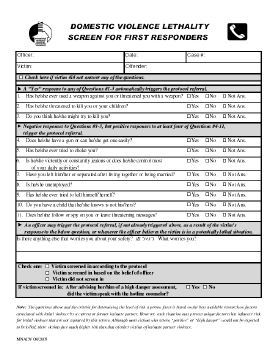
While lethality assessment and risk assessment are overlapping concepts, they do not measure the same thing. The main difference is whether a tool was designed to measure 1) the risk of reoffense/reassault (the likelihood that abuse will occur again, often measured after corrective action has been taken, a.k.a, “recidivism”) or 2) the risk of homicide (the likelihood that a fatality will result). After the general resources provided below, you will find materials related to six leading assessment tools. Each tool includes a notation about the field of intended use, the perspective being evaluated, and an indication of whether the tool assesses reoffense/reassault or lethality risk.

The Empowerment Process Model illustrated here (Bennett Cattaneo & Chapman, 2010) provides a helpful framework for engaging in risk assessment that shifts the focus from prediction to management. Lauren Bennett Cattaneo (2011) suggests that instead of asking, "What are the chances violence will occur?" we should instead ask, "Under what circumstances might violence occur, and how might we change them?" Effective risk assessment practices need to pull prediction into management, give victim voice, and integrate advocate expertise.

Integrating Risk Assessment in a Coordinated Community Response from the Battered Women's Justice Project explores the benefits of utilizing risk assessments and reviews the various available tools. It offers considerations and resources to support CCR teams engaging in this process.
This webinar presents three areas of research on risk assessment in intimate partner violence and describes future directions for linking research and practice in a way that pulls prediction into management, gives victim voice, and integrates advocate expertise.
This document critiques several lethality assessment tools and examines the link between these instruments and research on domestic homicide. Discusses the antecedents of lethal violence and utility of dangeousness assessment tools in promoting safety.
This paper describes several risk assessment instruments available to the corrections community, and addresses frequently asked questions regarding implementation and other considerations.
This report provides descriptions and analyses of assessment tools, investigative checklists, and protocols used by criminal justice personnel in Canada to measure risk in domestic violence cases.
This meta-analysis reviews the predictive accuracy of different approaches and tools that are used to assess the risk of recidivism for male spousal assault offenders.
The central purpose of this study was to assess the accuracy of several different approaches to predicting risk of future harm or lethality in domestic violence cases.
This report summarizes project PROTECT which aims at contributing to the prevention and reduction of the most serious forms of gender-based violence against girls, young women and their children, such as grievous bodily harm, homicide and attempted homicide, including so-called honour crimes and killings.
Overview of potential sources of harm to children from contact with batterers, recommendations for evaluating risk, and assessment guidelines that professionals can apply in cases where a batterer admits to a history of abusiveness.
These checklists are intended to help jurisdictions ensure that their criminal justice responses identify and address potential risks to victims, based on sound research on risk factors associated with IPV.
This document offers a listing of screening/assessment tools utilized in the evaluation of lethality risk in the context of in intimate partner relationships.
Danger AssessmentIntended field: advocates/health professionals
Perspective: victim
Assesses: lethality risk and reassault

Domestic Violence Lethality Screen for First Responders
In 2003, the Maryland Network Against Domestic Violence established a statewide Lethality Assessment Committee. This committee developed an assessment instrument called the Lethality Screen for First Responders(plus a protocol) using the Danger Assessment as a guide (see page 5). The instrument is currently being used by law enforcement in all Maryland counties. When victims (in an intimate partner relationship) screen in on the Lethality Screen as being in High Danger, the officer on the scene calls a domestic violence hotline and encourages the victim to speak with the hotline counselor. If a victim seeks services from a domestic violence program, in addition to normal intake procedures, a program counselor will conduct Dr. Campbell’s Danger Assessment, and the program will provide a range of enhanced services that consider the victim's assessed situation
The Danger Assessment (DA) was originally developed by Co-Investigator Campbell (1986) with consultation and content validity support from battered women, shelter workers, law enforcement officials, and other clinical experts on battering.
The findings reported here indicate that the Danger Assessment tool can assist in assessing battered women who may be at risk of being killed as well as those who are not.
This report shares results of an action based research project on Danger Assessment useage in nine Alberta shelters over a two year period. Fourteen (14) practice-focused recommendations are provided in this report.
The revised Danger Assessment (DA-R) is intended to predict reassault, not lethality, in abusive female same-sex relationships.
The revised Danger Assessment (DA-I) is a culturally competent adaptation for use with immigrant women and is intended to predict reassault in abusive relationships.
Intended field: criminal justiceThis report shares findings that support the concurrent and predictive validity of the DVSI-R and show that it is robust in its applicability. The findings further show that incidents involving multiple victims are highly associated with DVSI-R risk scores and recidivistic violence.
This Sanctions Update focuses on the DVSI-R: what it is, how it is used in the courts, how it benefits system players and victims, and what the next steps are for refining it even further.
This report contains analyses of the Domestic Violence Screening Instrument (DVSI), indicating that the instrument is accurately classifying offenders based on risk.